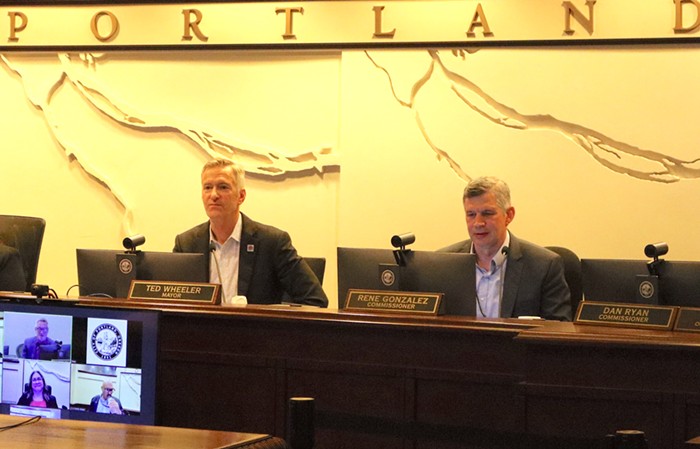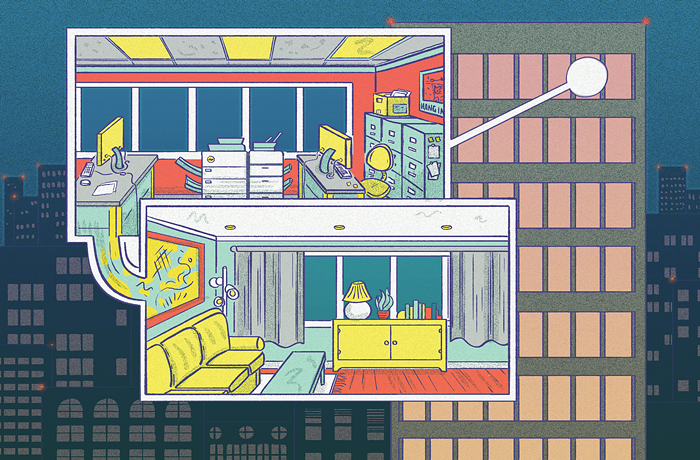"Hello. My name is Maxwell."
I forgive Maxwell for not recognizing me. Apparently he's forgotten that we'd met last summer at PDXBOT, Portland's annual robotics exposition. Instead of reminding Maxwell of my name, I choose to shake the hand of his God, his creator, Mark Medonis.
Medonis doesn't remember me either. Thousands of people were at the event, most of them taking turns manipulating Maxwell, and peppering Medonis with questions about his robot.
Pennsylvanian by birth, Medonis, 34, now works in Vancouver, WA, making infrared thermometers used in semi-conductor chip manufacturing. His robot bug was born in the Silicon Valley, where he worked, and later joined an amateur robotics club in San Francisco. Physically? Well, his inner nerd barely shows. He's a definite Clark Kent type, dabbling in androids.
THE ANDROID FACTION
Medonis' long-term experiment, "The Maxwell Project," combines a head with robotic features, along with realistic mechanical facial motions and voice. He's got chopper joysticks, a PC, and keyboard. Whatever you type in, Maxwell says back to you, moving his head, jaw, and eyes. Even dirty stuff like "BITE ME."
What makes Maxwell unique is the speech synthesis program Medonis designed, which syncs the voice with the head and jaw movements. When Maxwell talks, he looks like he's talking. This, Medonis believes, "takes Maxwell from the realm of animatronics into the realm of androids."
Of course, it takes a working knowledge of servos and other fancy robotic terms and tools to build a robot, whether it's a feisty little Sumo class fighting robot, a robotic asparagus picker, or something as humanly/robotically realistic as Maxwell. You don't have to be an electrical engineer like Medonis to build one of your own, because not all robot enthusiasts think alike.
"I represent the android faction... a certain area of robotics," Medonis says. "In the United States, there are very few people building android robot heads. There are only a couple of universities exploring this, and very few hobbyists. It's an area of robotics that really hasn't been explored."
CALLING DR. DOOM
In the mid-'90s Medonis interviewed for a job at Jim Henson's Creature Shop, in Burbank, and paid a visit to the set of Dr. Doolittle.
"I saw all their stuff up close," he says. "I saw the inside of a lot of different heads--all kinds of different animals and creatures. Of course theirs are really complicated. You look inside and you start to figure out, 'Oh... okay, this part goes here... it moves the eyes like this... the lip-sync works like this...,' and so on.
"They couldn't hire me, but I came back thinking, 'Wow! Those heads were really neat! I betcha I could build a head.' So I did. I sat down, spent about six weeks, and designed my own head. I found the mask, constructed the eyeballs, and built it all on the workbench in the living room of my apartment."
Maxwell's face is based on a modified Halloween mask: "Dr. Doom from Spider-Man comics."
Today, Medonis sells DIY kits of Maxwell for about $350. He hoped these would finance future R&D. Though sales have been less than stellar, PSU's robotics program bought 10 heads. Anyone who can build a model, he says, can build and customize a Maxwell.
"No problem," he assures me. "I made a platform for people to build on. All you have to do is put the parts together and throw a little glue around. I designed the kit to be snap together and go."
SHOW ME YOUR ROBOT
Medonis says there are dozens of hobby robot types to choose from. Nano, Micro, Mini, and Japan class Sumo robots (not actually shaped like Sumo wrestlers, but square arena fighters on wheels that think for themselves). Plus there are "walkers," little things that crawl around like insects, gigantic mechanical monstrosities--even teams of mini-soccer players.
"Some guys are really into the highly technical stuff," gleams Medonis. "Carbon-fiber chassis, awesome Sumos. And other kids come in with little stick robots with only a couple of transistors... there are all kinds of ideas, and all kinds of robots. I find the variety terribly exciting. All these different crazy ideas of what a robot should be.
"Years ago people were messing around with radio control airplanes, train set models. Robots now seem to be the big attractor. It takes work, and 3-D CAD (computer-aided design)--not to mention assembling the thing, troubleshooting, programming, and all that jazz.
"There is nothing quite like the feeling when you have the electronics working, the software boots up, you turn on the power switch, the LED comes on, and suddenly your robot moves forward. It's doing its little routine or interacts with you the way it's supposed to. There's a certain charge from doing what I do, and I think that's what drives a lot of these robot builders."
WHAT ROBOTS SHOULD BE
Although he started out making competition bots, Medonis instinctively knew he could do better.
"I got tired of building those little silver arena cars. People come over to your house and they go, 'You build robots? Show me your robot!' Then you roll out some little car, and they're like, 'Oh.' See, they had a different idea of what robots should be: C3PO walking up and saying hello and shaking their hand."
"But you know, I'd love to see that sort of thing in my lifetime... the wonderful dream I was sold on for years. I read all the Asimov books, and they talk about all these helper robots. Robots sitting in your house telling you stories... Robots that look like what I think robots should look like--and frankly, what a lot of people think robots should look like; a silver robot with face and eyes, who recognizes you. A voice you can talk to, and the conversation goes back and forth.
"I like to think I have more optimism than cynicism. So I hope that American companies will become more interested in building interactive, humanoid robots, instead of pumping money into flying UAVs (Unmanned Aerial Vehicles) with hellfire missiles, and driverless Humvees that go tooling off in the desert by themselves. I think there are better things we can do with all that money."
MAXWELL: MASTER THESPIAN
At PDXBOT.04, PSU students will be presenting a never before staged event. An acting troupe of 10 modified Maxwell robots will take the stage, and deliver their theatrical goods.
"They're setting all the robots up as actors," Medonis laughs. "They're going to have (them) stage a play. Both the computer department and the drama department are working together. It's an amazing project.
"Dr. Perkowski (PSU Professor of Electrical Engineering) brought back all these masks from Korea that they use for traditional plays. The department modified all these Maxwell heads and added these beautiful hand-carved masks with moving jaws and different eyes. Now each one has its own flavor and personality. It's amazing to me that they're going to show off their stuff at the show. It's great. I'm happy to see the heads entertaining people."
UPGRADE ME
But don't expect Maxwell to leave Portland for the lights of Broadway. Even after PDXBOT.04, Maxwell will continue evolving. He's a work in progress.
"A lot of my ideas are for a more flexible face, more servos," Medonis says. "I'd like to do those things, but I think I'm going to put them on the back burner for now. There's a couple of software ideas I have that would add to the functionality of the robot, and its entertainment value, too."
He expects to someday utilize Maxwell's existing PC features, integrated with new speech recognition technology.
"If he has wireless Ethernet [Maxwell does], then he has access to the web. Then if you add speech recognition, now you can ask him questions. These things you have to sit down at the keyboard and type into Google? There's no reason why Maxwell can't go through Google or any other network database."
Or, for that matter, read you a comforting e-book.
"A short-term goal is to add more robotic type features. More interaction. So rather than just being the smart puppet he is now, he becomes more of what I want him to be--a robot."
See robots battle and meet Maxwell at the PDXBOT.04 Robotics Competition and Exposition. Sunday, June 6, PSU Smith Ballroom, 10:00am to 5 pm. Free to all.


















